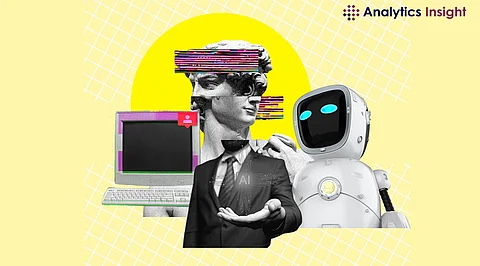

Artificial Intelligence is the frontline of various innovative technologies, associating human-like minds, learning capabilities, problem-solving, and decision processes with computer system applications. It associates systems to think like humans, learn from experiences, and improve over time.
AI is not a future imagination but a current reality, associated with our daily lives via autonomous vehicles, virtual assistants, and recommendation systems.
As we understood briefly what is artificial intelligence, now let’s get a glimpse about its history and journey. AI began with Alan Turing's question, "Can machines think?" This led to the Turing Test and the subsequent development of computational machines that could mimic cognitive functions. Over the decades, AI has evolved from simple rule-based algorithms to complex neural networks capable of deep learning. Today, AI systems can defeat grandmasters in chess, create art, and even drive cars.
AI can be categorized into three types:
1. Narrow AI: This AI excels in specific tasks, such as language translation or facial recognition. It operates under a limited pre-defined range and is the most prevalent form of AI today.
Recommendation engines are among the several commercial applications that narrow AI may offer. Narrow AI applications are growing more complex as learning algorithms get deeper. Given the complexity of the human brain and the current challenges faced by data scientists and ML engineers in developing self-supervised machine learning algorithms, there is still much disagreement regarding how well computers will ever be able to attain general artificial intelligence.
Artificial narrow intelligence systems retrieve information from a particular dataset and are designed to focus on a single task at a time. Put otherwise, these kinds of systems only carry out the designated duties. Narrow artificial intelligence is not the same as broad AI; it lacks consciousness, self-awareness, feelings, and true intelligence comparable to that of humans. These systems function within preset and specified settings, restrictions, and contexts, despite their apparent intelligence and sophistication.
2. General AI: An AI that possesses the ability to understand, learn, and apply its intelligence broadly and flexibly, akin to human cognition, is known as General AI.
The theory of mind AI framework serves as the foundation for AGI, often known as strong AI or deep AI. The core idea behind mind-level AI theory is to teach machines how to think like humans and comprehend the basic components of consciousness. AGI can gain cognitive skills, plan, make decisions, deal with uncertainty, incorporate past knowledge into decision-making, and increase accuracy thanks to its robust AI base. AGI makes it possible for machines to carry out inventive, creative, and imaginative tasks.
3. Superintelligent AI: A hypothetical AI that surpasses human intellect and capabilities, Superintelligent AI could potentially solve complex problems with ease and speed beyond our comprehension.
Superintelligent machines possess self-awareness and are capable of abstract thought and interpretation that is beyond human comprehension. This is due to the fact that just a few billion neurons in the human brain are capable of thought. In addition to mimicking the complex behavioral intelligence of humans, ASI is also capable of comprehending and interpreting human feelings and experiences. Based on the AI's comprehension capacity, ASI creates its own emotional understanding, beliefs, and desires.
Systems with artificial intelligence use data and algorithms to function. First, in a procedure called training, vast amounts of data are gathered and fed into mathematical models, or algorithms, which utilize the data to identify patterns and provide predictions. After training, algorithms are used in a variety of applications, where they continuously absorb new information and adjust to suit it. As a result, AI systems can eventually carry out difficult tasks like data analysis, language processing, and image identification with increased efficiency and accuracy.
As we have seen over what is artificial intelligence, its history, and its types, AI's benefits are vast and varied:
• Efficiency: AI automates routine tasks, freeing humans for creative and strategic endeavors.
• Healthcare: AI aids in early disease detection, personalized treatment plans, and managing healthcare data.
• Business: AI enhances customer service, optimizes supply chains, and personalizes marketing strategies.
• Scientific Research: AI accelerates the pace of research, from drug discovery to climate modeling.
It is necessary to address ethical issues as AI transforms industries. Regulation and cautious supervision are necessary to address concerns about decision-making biases, privacy invasion, and job displacement.
Artificial Intelligence is a collaborator that enhances human talents, not a substitute for human labor. It necessitates a staff trained in AI development and management and opens up new job prospects.
The AI industry offers a plethora of career options:
• AI Research Scientist: Innovators who push the boundaries of AI capabilities.
• AI Software Developer: Creators of AI-driven software solutions.
• Data Scientist: Analysts who interpret complex data through AI algorithms.
• Robotics Engineer: Designers of intelligent machines that work alongside humans.
AI is revolutionizing and reshaping our world. It offers a wide range of benefits, with a story of its challenges.
As AI is evolving to advance, staying updated and getting prepared is important for utilizing its potential responsibly. The future is all AI, and it is in our hands to embrace and shape it.
Hence, this article explores what is artificial intelligence, the types of artificial intelligence, the benefits of artificial intelligence, and the careers in artificial intelligence it presents.
Join our WhatsApp Channel to get the latest news, exclusives and videos on WhatsApp
_____________
Disclaimer: Analytics Insight does not provide financial advice or guidance on cryptocurrencies and stocks. Also note that the cryptocurrencies mentioned/listed on the website could potentially be scams, i.e. designed to induce you to invest financial resources that may be lost forever and not be recoverable once investments are made. This article is provided for informational purposes and does not constitute investment advice. You are responsible for conducting your own research (DYOR) before making any investments. Read more about the financial risks involved here.
